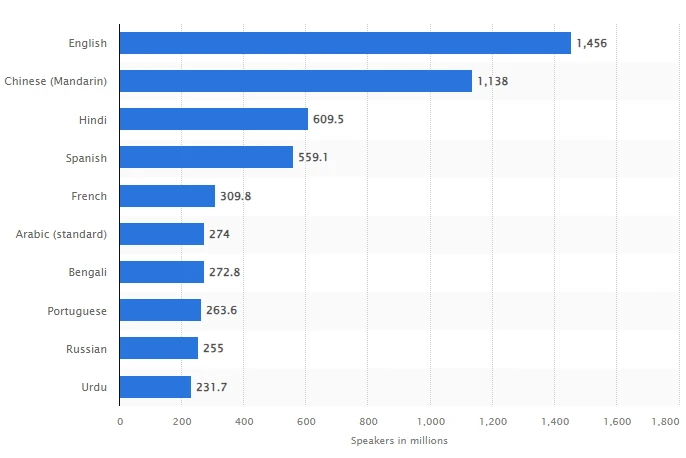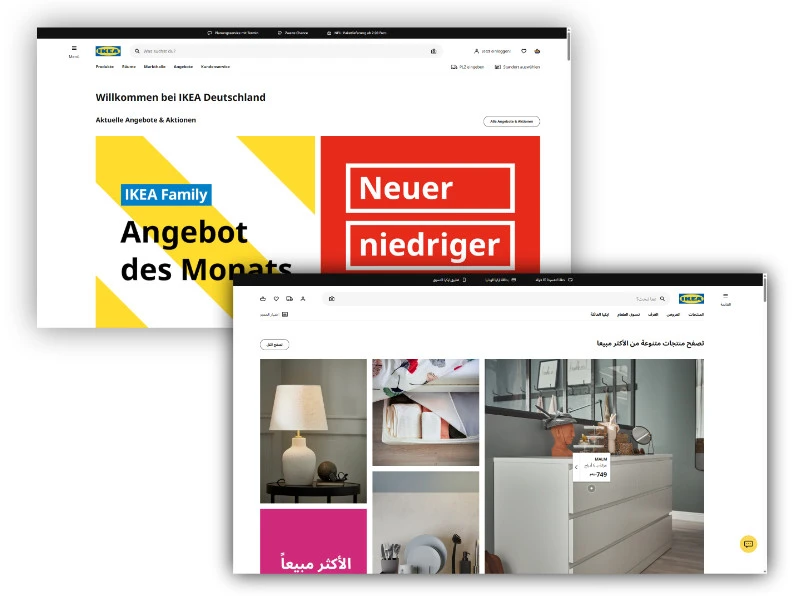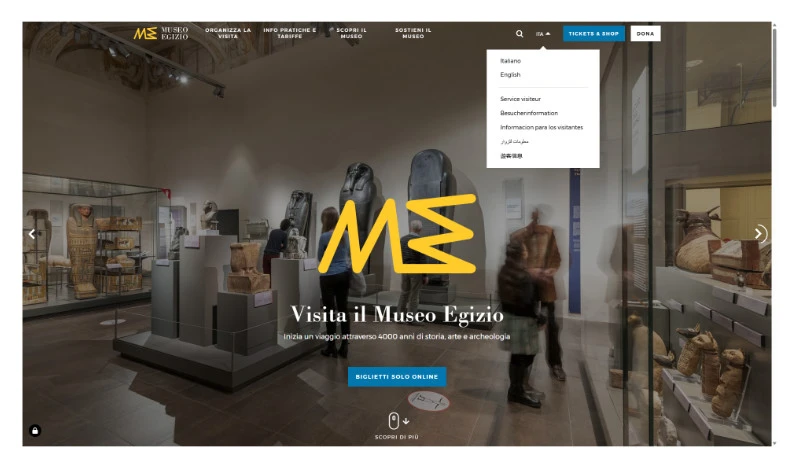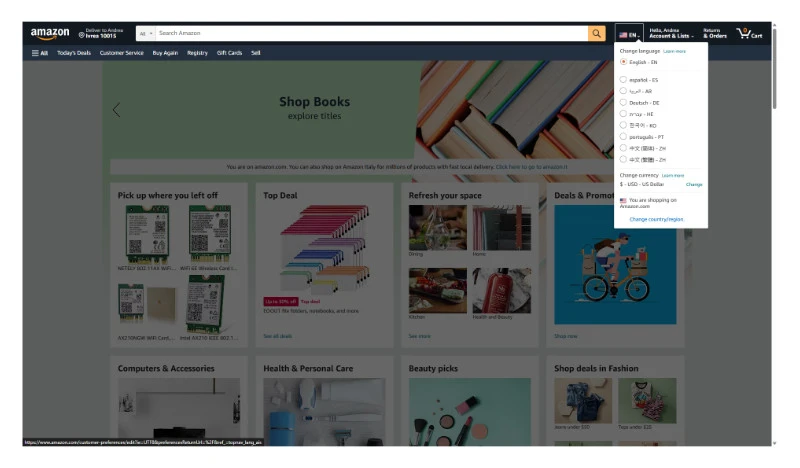Multilingual websites: the complete guide
Published by Incomedia in Guides and Tips · Thursday 24 Aug 2023
大家好! Hey allihopa! Hi sa lahat!


If you don't have the faintest idea what this means, you are in the same boat as those who open a website and discover that they know little or nothing at all about the language it uses. (Don't worry: it was just a friendly "hello everyone" in Chinese, Swedish and Filipino).
Even if you sometimes don't think about it, most people on this earth don't speak the same language as us. That's precisely why it's important to have a multilingual website: it is advantageous for anyone who wants to build a solid online presence, and it is essential for companies that export their services abroad or that, in any case, deal with foreign customers.
Let's explore the topic together. We will better understand what a multilingual site is, what the benefits it guarantees are and, above all, how to create one like a pro and without making mistakes.
What is a multilingual website?
Let's proceed in order and let's start with a definition.
A multilingual site is a website that offers users the possibility of browsing and reading the content in the language they prefer, among those made available.
Generally, the site is identical in terms of graphics and structure for all available languages: what changes is only the language in which the content can be viewed by the user. But there are cases, as we shall see, in which the differences between the various language versions are more substantial.
The goal of a multilingual site, therefore, is clear: to reach and communicate with potential clients of different nationalities speaking, as far as possible, their own language or, at least, a language that they may be familiar with.
How many and which languages to choose?
It has been shown that 8 out of 10 people prefer to read a website written in their native language and that they tend to stay longer on the website.
The fact is that there are over 7,000 languages in the world and it is certainly not possible to cover them all. Even narrowing down the circle by choosing only the most commonly spoken languages is not a winning strategy: there are still many and it is not guaranteed that they will satisfy our users.

The most spoken languages in the world in 2023 - (source Statesman)
Paradoxically, not even relying on English alone may be the best choice. Of course, English is the most widely spoken language and currently 80% of website content is only available in this language. However, despite this, around 70% of Internet users DO NOT have English configured as their first language.
So how can we understand which languages we should translate the content of our website? The best approach is to start from the analysis of your reference targets. The languages into which a website must be translated are those of the people (or markets) you want to address. Analyzing website access data can help you understand the countries from which visits come and, more precisely, to identify the languages to be developed.
Generally, considering that each additional language requires an investment of time and resources, it's worth your while to carefully choose 2 or 3 languages indispensable for talking to your audience. If needed, you'll always be able, in the future, to add other new languages to the site.
What needs to be translated?
In general, answering this question is very simple: you have to translate everything!
Let's say, for example, that you have decided to have a site in Italian and English. You could create the Italian version, make a copy of it and then replace all the Italian text with the English translations.
During this process, you have to be meticulous and find every piece of content: not only page content and articles but also buttons, menu items, form labels, footers, legal notices, privacy policies, etc. Every piece of content, from the most substantial and evident, to the smallest and most hidden, must be translated and replaced.
Translating everything to get versions that differ only in language is certainly feasible for relatively simple websites. However, when websites are very rich in pages, functions and content, things can change. In these cases, it could be strategically more advantageous to decide to localize only some parts of the original site.
Always start with your audience: think about what they really need to know and based on this decide what is essential to keep in the translated version of your website. There will be some parts that you must keep (the mission, services, etc.), and others that you can omit: if you make the right choices, you will get a "lighter" but equally effective version of your site.
How is the content translated?
If you are thinking of using a machine translation service to translate your website content, before proceeding, stop for a moment to reflect on the implications of your choice.
It is true that in our everyday lives Google translate is able to help us a great deal with languages and that the quality of translations - especially in some languages - has improved over time. Despite this, it remains an unsuitable tool for translating a professional website. Google Translate fails to grasp the linguistic nuances of content and is inaccurate, sometimes making major mistakes. It is quite likely that the final result will be of poor quality and that this will cause distrust in your international audience.
To have the guarantee of obtaining content that is not only correct, but also perfectly adapted for the destination country (number or date formats, local expressions, etc.), you should rely on the services of professional translators. You can use specialized agencies or freelancers who also offer their services through portals. The most sensible advice we can give you is to take some time to evaluate alternative offers and identify the one that can guarantee you the best relationship between the cost and the quality of the service offered.
If until recently, talking about these 2 approaches - automatic translation with Google Translate and professional translators - would have exhausted the subject, today, one additional player has entered the field, which should not in any way be underestimated: Artificial intelligence. Not only can we find generative AIs like ChatGPT, which are able to write content in different languages, but there are also assistants based on Artificial Intelligence specific for the translation of text content. One of them is DeepL which, while offering automatic translations, promises results 3 times more accurate than its competitors. You can try the service for free and then eventually upgrade to a paid plan to continue using the system. Before proceeding further, the service is definitely worth testing.
How do you design the layout of a multilingual website?
When it comes to multilingual websites, the question of text localization is central, but the aspects related to graphics are also equally important: in this case, in fact, the effort to guarantee an optimal user experience is multiplied, as it is necessary to satisfy all the nuances implicit in a wider and more diverse audience.
Here are some key aspects to keep in mind when designing the layout of a multilingual site:
- Develop a flexible layoutWhen developing the layout of your website, you must take into account that a user could access the version in one language and then decide to change it: it is important that, whatever version the user is on, they are always sure of being on the same site. For this reason, all language versions, however much they may differ in order to conform to specific needs and tastes, must return an unambiguous and coherent image of the brand.
 The Ikea site has a clear and simple layout that lends itself well to the variations of each language
The Ikea site has a clear and simple layout that lends itself well to the variations of each language
In addition to this, we must bear in mind that some languages, such as Italian, follow a writing format from left to right, white others, such as Arabic or Hebrew, follow a writing format from right to left. In addition, some languages require more space for text than others. A flexible layout, therefore, is also able to adapt to all languages, hosting the graphic elements that vary and providing the right space for content in its various expressions. - Make the user's language choice easyIn a multilingual site you need to allow your users to easily switch from one language to another. A popular way to do this is by providing a drop-down list where the user scrolls to select their preferred language.
 The Egyptian Museum of Turin offers the choice between Italian and English, but also includes a page with key information in French, German, Spanish, Arabic and Chinese
The Egyptian Museum of Turin offers the choice between Italian and English, but also includes a page with key information in French, German, Spanish, Arabic and Chinese
Another alternative is to list the languages directly. Typically, whether you use a drop-down menu or a list of items, these are placed at the top of the header or at the bottom of the footer. Both choices are correct as long as they are simple enough to easily spot by the user. Amazon lists the languages directly on the web pages
Amazon lists the languages directly on the web pages
A fairly common mistake, however, is choosing to use flags to represent languages: in doing so, it is not possible to manage countries with multiple languages or that share a language. It is much better, instead, to write the names of the languages directly in the local language: for example English, French and Italian will be shown in the list as "English, Français, Italiano". - Use culturally appropriate colors, icons and symbols
The classic example to understand what we are talking about is white: for us, Westerners, white is a color associated with purity and candor, while in the East it is the color of mourning and death.
When designing a multilingual website, therefore, be aware that graphic elements considered elegant or innocent in Western countries may be offensive in other cultures. For this reason it is best to avoid images of hands, animals or religious symbols and use photos of culturally appropriate people. When in doubt, it is always best to do some extra research or consult with locals. - Choose images without embedded text
It's not a mistake to create and use an image containing text, as long as you remember that this too will need to be localized in the different languages.
By keeping the graphics and text separate, the images will not have to be recreated and the page can be localized more easily. - Test and optimize usability
Finally, remember to test to make sure the site is intuitive and easy to use in all languages. The best thing is to ask for feedback directly from native-speaking users: thanks to this approach, you will be able to identify any problems related to navigation or to understanding the content and take the necessary actions to correct them.
How do you design the SEO of a multilingual website?
The positive aspect is that a site that offers content in multiple languages is appreciated not only by users, but also by search engines which, in general, reward them as being able to guarantee a better user experience. To obtain this result and see our site well positioned in the Search Engine Results Pages of the countries we are interested in reaching, however, we have to work on the International SEO aspect, intervening on technical aspects such as URL architecture, tags and page codes.
Choose the structure of your URL
There are essentially 3 domain name strategies you can adapt to help search engines find and understand which country and language your website targets:
- Subdirectory
In this case, we have a domain and many virtual folders, one for each set of localized content. It is one of the most commonly used methods, since it is quite simple to implement, as well as quite efficient in terms of resources and effort.
- Subdomains
Creating a subdomain for each language gives you great flexibility: a subdomain is like a standalone site, and therefore you can have different layouts and content for each language.

- DomainsRegistering a separate domain for each language, using a Country Code Top Level Domain (ccTLD), certainly gives a strong signal to both search engines and users. However, this certainly requires an additional investment and it is not certain that a specific ccTLD for the domain name is available or can be registered (for example, to register a .DE domain you must be an individual or an organization operating in Germany).

Configure hreflang tags
Thanks to the Google Search Console, you are able to provide a general indication to the search engine on which results to show and in which language. However, to strengthen the relationship between the different pages, you need to go a step further and configure the hreflang tags.
Hreflang is an attribute that indicates to the search engine that the language pages are not duplicate content, but simply other versions.
These can be placed in the link element on each individual page, in HTTP headers or in the XML sitemap markup.
Work with keywords and personalized content
Simply translating the keywords used to optimize the site into your native language is never an ideal choice. Every market and every language, in fact, has its specific characteristics. It is therefore highly recommended to avoid automatic translations and try to identify a specific set of keywords for each language to work on.
One tool that can prove to be particularly useful in this process is Google Market Finder. Entering a starting keyword, this tool first of all allows you to determine the corresponding average monthly search volume, country by country.
Thanks to this approach, you immediately have an idea to assess which markets may prove to be strategically important. In addition, you can take advantage of the "Learn more" option and the tool will offer you the keywords in the specific language, corresponding to the starting one, for the countries selected and ordered according to relevance.
With this type of information at your disposal it will be easier for you to find a group of specific keywords for each market and, consequently, to create specific content capable of satisfying the needs and tastes of your various audiences.
How do you create a multilingual website?
At this point it should be clear how important it is to have a multilingual site and what aspects must be taken into consideration in order not to make mistakes in its design and creation. One last aspect remains to be addressed: how do you actually create a multilingual site?
With software like Website X5, anyone can create a multilingual site. The starting point is to create the site in the main language, for example Italian: thanks to the wizard and the builder based on Drag&Drop Objects, you can quickly customize the template and compose the various pages of your website. Once you have completed the site in its Italian version, all you have to do is duplicate the project to obtain a copy for each additional language you want to add. At this point you can open each copy and proceed with replacing the content in the specific languages.
WebSite X5 offers a series of functions that can be very useful for creating your multilingual website:
- MagicText: an assistant for generating text content based on Artificial Intelligence. Use it to find new ideas and write titles, SEO titles and paragraphs: remember that it knows many languages and can change its tone according to your input.
- Google Translate widget: for pages that you can't or don't want to localize in any other way, you can always make this widget available. The user can call up the Google Translate translation window and use the service to at least have an automatic translation of the page at their disposal.
- Language Choice Object: obviously you are free to create links as you see fit to allow users to choose the language. An alternative is to use the Language Choice Object to configure a drop-down menu listing all the available languages.
- Automatic redirection based on the browser language: this allows for the most correct language version to automatically be proposed to the user.
- UTF-8 encoding of characters: this allows you to create your sites in any language, including those that use alphabets other than the Latin one such as, for example, Greek, Cyrillic, Coptic, Armenian, Hebrew and Arabic, without neglecting Chinese, Japanese and Korean.
So, are you ready to create a website that is finally understandable by everyone? If you haven't done so already, download the trial version of WebSite X5 and get to work. Plan everything there is to do well and you will quickly see that you will open up your website to the world much sooner than you imagined.

